With endless ways to spend your marketing dollars, allocating budgets in the digital space can be a struggle for brands and marketing professionals. Over-allocate to the wrong channels and you risk wasting money on tactics that don't produce qualified results. Under-allocate a high-performing channel and you miss out on valuable opportunities.
So, what's the best way to avoid mistakes in spending and ensure you get the most from your available marketing dollars? To help, we share some common difficulties with setting digital marketing budgets—and provide tips on how to set and optimize your budget.
Budgeting for digital marketing is a journey, not a destination
A lot of times, we treat digital marketing budgets like we treat our New Year's resolutions: we set them, we get excited about them, and then we fail to stick to the plan. We abandon about 80% of our resolutions by February, and by the end of the year, only about 8% of our resolutions are actually accomplished and I think we can do better. So we're going to walk through some of the ways that we help answer the question, "What is a good budget for digital marketing in 2023?"
We try to answer the digital marketing budgeting question a lot of different ways but it stems from the most common question we get in a discovery and kick-off process with our clients: how much should I spend on digital marketing? Or, how much should my marketing budget be in general? And we have a lot of different sources for that information, so we have to start to address that question and typically it comes down to my favorite answer: "It depends."
There are a lot of different data points, a lot of different ideas and schools of thought on how to set marketing budgets, and what we propose to do is backtrack and start with your business objectives and make sure that we're answering the questions that matter to your business. We're going to start with your goals, your objectives, and your targets. Now we're going to develop strategies and tactics around that, that ultimately lead to revenue. If we can't tie your goals and objectives to an increase in revenue, or whatever your business objectives are, then our strategies, and tactics, and budgets aren't really that useful for you as a business.
So in our journey today, we're going to talk through several key topics related to setting budgets. First of all, why is it even important? How do we consider different factors when we're setting our budgets? What do we need to consider when we're setting a budget? And then how do we roll all of that together into a more informed digital marketing budget? And finally, we're going to share some tips on how to get started.
Build a Budget That's Future Proof
We've compiled the blueprint for a future-proof marketing budget in 2024. This free guidebook has insights from top CMOs, smart ways to budget for AI, and how to plan for all the big changes in marketing so you don't get left behind. Get your copy today and feel more confident in your marketing investment.
Why create a digital marketing budget plan?
First and foremost, why do we need to set a budget? This should be obvious, we're all in business to succeed and grow and accomplish our objectives. So setting a budget is simply a way to plan ahead and make sure we're allocating enough resources to accomplish what we need to accomplish. It's not exactly a glamorous task but a lot of times it has to be done and we can do it with a little bit more discipline and rigor than simply throwing numbers up on a wall.
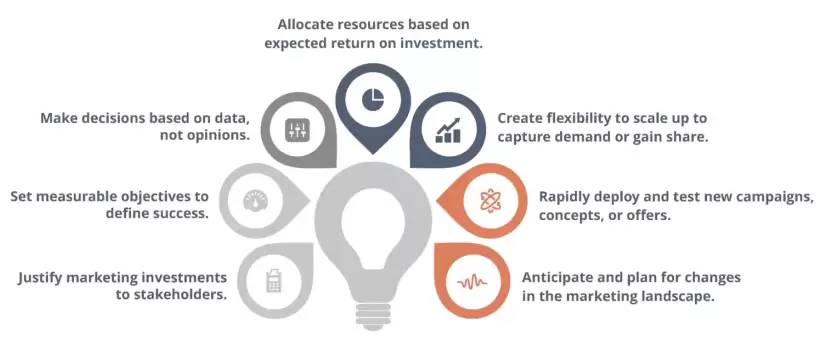
So budgets matter for a lot of different reasons. We have budgets for justifying our investments to our stakeholders. We have to set measurable objectives if we're going to define success to those stakeholders. We like to make decisions based on data, not opinions. We have to allocate the resources we do have based on the expected return on investment so we can prioritize those channels or tactics or strategies that are yielding the best results. We have to retain some flexibility in our budgeting and strategy process to make sure that we can scale up to capture demand when there's an incremental opportunity. And we also want to have flexibility so we can deploy new tests and learn some new things along the way and not be set into a rigid structure or rigid budget for the year if it doesn't allow us to anticipate or plan ahead for changes in the landscape or competitive setting.
How to budget for digital marketing
So while we're factoring all of these into our budgeting options and budgeting processes, we have to think of some of the other considerations we need to plan ahead for. To do that, we looked at a lot of industry research. We can start with what other marketers—what other senior-level marketers—are doing to project their budgets ahead into the coming year, and there's no better source for us right now than a survey of CMOs and senior-level marketing executives by the Duke School of Business, the Deloitte consulting firm, and the American Marketing Association. They've combined their resources and methodologies over time to survey senior-level marketing executives about their levels of optimism and their enthusiasm for increasing their budgets in the coming year based on what they're seeing in their businesses today and what they see in the marketing landscape for the year ahead.
We know that the internet and digital marketing in particular is getting more competitive. More of our competitors are coming online, they're increasing their budgets, and they're generally seeking to acquire the customers we already have or gain impression share or market share where it exists.
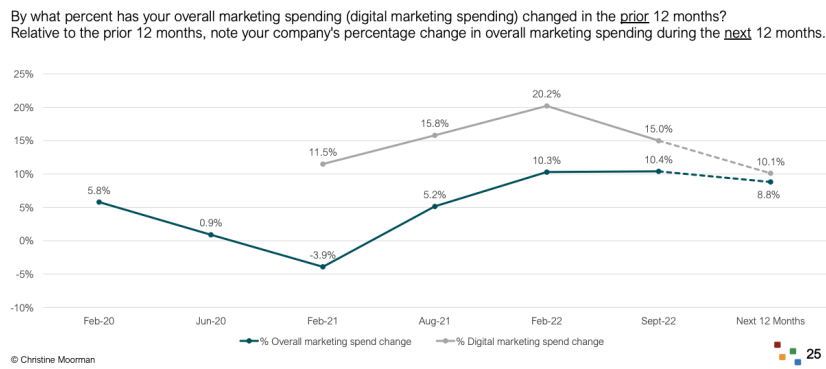
Over the next 12 months, marketers are expecting to spend about 10% more than they had in the previous months.
Over the next 12 months, marketers are expecting to spend about 10% more on digital marketing than they had in the previous months. Their total marketing budgets are going to grow 9% in the coming year, which means they're anticipating being able to acquire more customers. They're allocating more resources and in our budgeting processes, we need to be aware of the fact that we can start to spend more to gain more and we should not consider the status quo or previous years' budgets as any indication of what we should be spending going forward.
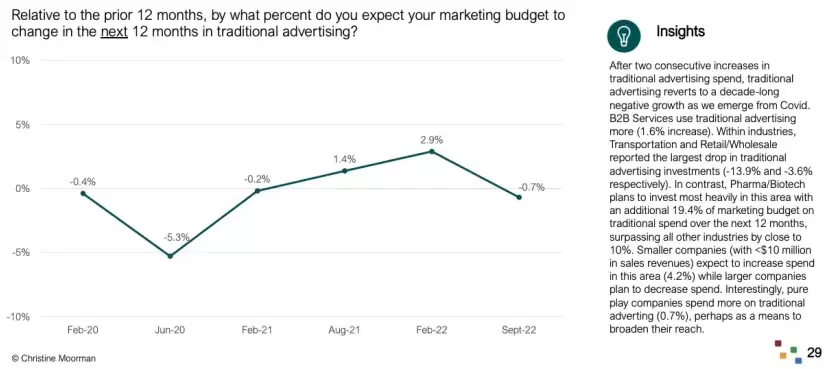
When we look at that overall 9% increase in marketing budgets, we can see that it's heavily weighted towards digital marketing. In fact, it's about a 10% increase in spend in digital channels versus a flat to negative projected spend in more traditional channels. So we know more of those marketing dollars are going online. This does vary by industry, but we do expect to see a higher growth in spending in more competitive segments, such as banking, media, consumer packaged goods, services, consulting, and technology centers.
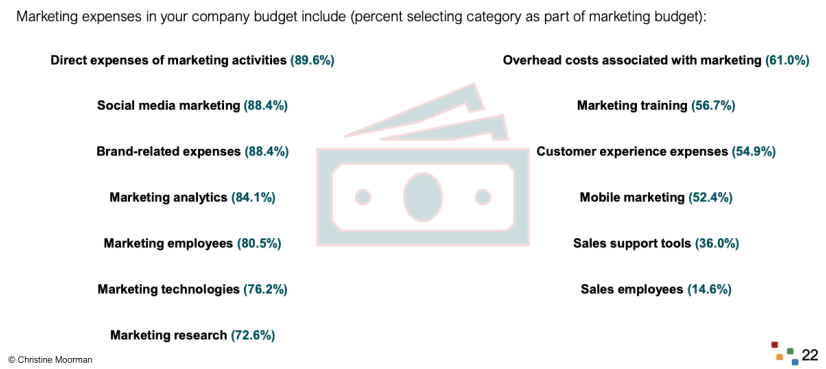
So another critical component in setting a marketing budget is factoring all of the related expenses and overhead in addition to the ad spend. So as marketers we're really good at forecasting how much we can afford to spend in advertising channels. In fact, 99% of us are factoring in advertising spend into our marketing budgets for the coming year. However, we're less effective at planning ahead for some of the other costs associated with our marketing strategies, such as analytics tools and software, marketing research, training the employees, the overhead, the staffing plans that we're going to need to execute on these strategies.
So when we take all of these factors into account, we have to make sure we're looking at the big picture and budgeting for each of these increases over the coming year. Another helpful tip, sometimes, is to look at industry averages or company averages across entire industries to figure out what percentage of our overall revenue should be allocated or are allocated to marketing expenses? On average, it's about 8.7% of gross revenues for a company are applied to marketing expenses. This is a baseline, it doesn't mean some companies should be spending more or less. It simply means that across all industry segments, about 9% of company's gross revenues are reinvested back into marketing efforts.
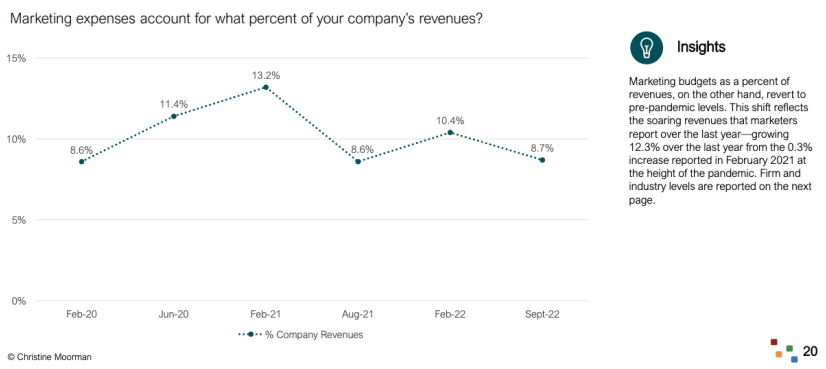
Informing your digital marketing budget
So when we start to look at what we need to do today to start planning our budgets for next year, as I mentioned, we have to start with our objectives. We have to know what Key Performance Indicators, or KPIs, are tied to our company's success. We have to look at how we're going to measure those and what we're going to do with that data once we get it. Most importantly, in any organization, we have to define who the accountable stakeholder is. This is the number one mistake we see people making: setting a goal without holding anybody or team or department or an individual accountable for hitting that goal. When nobody owns the goal, it doesn't get done and everyone has an excuse to hide behind.
This is the number one mistake we see people making: setting a goal without holding anybody or team or department or an individual accountable for hitting that goal.
Timing & Duration
We set our objectives, but we should also be putting some time constraints around it: What do we want to accomplish, and by when? Sometimes it's an annual goal, sometimes it's a quarterly or monthly target. We need to define that ahead of time so we know what we're aiming at and what we need to prioritize.
Risk Tolerance
We have to assess our own risk tolerance: Do we have enough budget, do we have enough resources to take a scatter shot approach to test multiple approaches at the same time? Or do we have to keep enough powder in the reserve and only focus on one or two opportunities at a time so we don't spread ourselves too thin.
Competitive Pressure
Competitors always play a big role in budgeting decisions. I wouldn't base your decisions based on what your competitors are doing but we need to know if we expect competitors to be more or less aggressive in the coming year and what opportunities or gaps we might see in their strategies that we can exploit that may help inform our budgeting process as well.
Data & Analysis Requirements
We need to take into consideration the amount of data, the types of analysis that we want to perform. We need to ask ourselves these questions: What do we want to learn? What kind of data do we need to collect? How do we want to store it?
Target Audience Behaviors
We need to understand more about our target audiences: Where are they going online? What are they browsing? What social media and content consumption tools are they using?
Analytics Tools & Methodology
What kind of analytics tools and data capture methodologies do we want to use? How are we going to take advantage of those to gather the types of data that we need? What's the cost upfront and on-going with those investments?
Visitor Acquisition Costs
How much is it going to cost to acquire traffic, this is typically represented in a cost-per-click (or cpc model), or cost per thousand impressions (a cpm model), depending on the type of advertisement we're buying and it's the most common form of advertising expense.
Staffing & Training
Of course, we have staffing and training needs, we have marketing team employees, we have agencies, we have the training and onboarding and systems that go along with supporting those teams.
Testing & Optimization
And a lot of us as marketers, we overlook the testing and optimization investment that needs to made to continually refine the use of our budgets, refine our ad spend, take a measurement driven approach to building our strategies and implementing them in an iterative fashion over time so that we can test and improve our way to better results.
When taken as a whole, all of these factors can help us build a more informed marketing and budgeting process so that we can make a better and more educated choice and decision about what we're going to do in the coming year.
Optimizing digital marketing spend
Now that we've established a digital marketing budget for 2023, and we have some guidelines for what we we project to spend in the coming year. We have to take into account the opportunities that we have to optimize that spend over time as we gather data. Budgets, inherently are fluid and can be reallocated, especially in the digital space to the channels that are working best to providing the best return on investment. So budgeting plans should include some flexibility to reallocate funds as needed to take advantage of opportunities and cut your losses.
To do that, we look at a couple different methods and we have to factor this into our planning and prioritization decisions. We have to test multiple channels, there's no silver bullet in digital marketing and what works for one advertiser may not work for another. So we have to look for ways to compare apples to apples across digital channels by comparing performance against the KPIs (or Key Performance Indicators) that we established earlier in our budgeting process. We have to look at those results side-by-side and look for the outliers: Where are we getting a better cost per conversion? Where we might have a higher conversion rate? How can we capitalize on those opportunities?
We also have to factor in, as best we can, customer data and lifetime value. What are we most likely to sell? What kinds of leads are generating the highest return on investment? If we're in an Ecommerce environment, where can we maximize lifetime value if we allocated more marketing dollars towards this specific channel? And finally, one of the best parts about digital marketing is, because everything is measurable, we can start to define an attribution model and assign a value to each of the touchpoints in our digital marketing funnel to make sure that we're properly optimizing our budgets and our strategies to take advantage of each of those touch points along the visitor journey.
How to get started
So let's take a look at how to get started. The first step is making sure we're investing in all of the right channels, and every business is different, no two strategies are going to look alike.
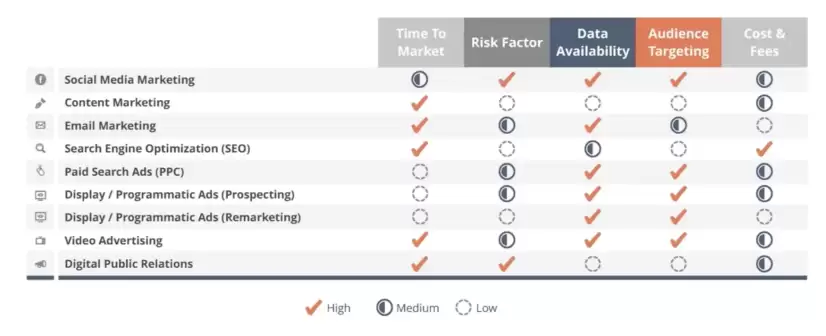
But we've curated this comparison table as a simple high-level overview of the various digital marketing services that you have access to and how they rank against each of the budgeting considerations that we looked at earlier: time to market, risk factors, the availability of data and analytics, how granularly we can target specific audiences, and relative costs and fees associated with each of those channels.
For example, we can look at paid search campaigns, or ppc campaigns, and see that we can have campaigns up and running relatively quickly and gather a lot of data with very granular audience targeting capabilities. However, because it's a paid channel, costs tend to escalate and can increase over time as we allocate more budget and take advantage of new opportunities. When we're looking at paid opportunities like paid search, or display advertising, or even paid social advertising, it helps to start with our objective in mind and one of the ways we can start to establish a budget is to look at how much can we spend, how much can we afford to spend to acquire visitors or traffic to our site? And assuming that these are all qualified visitors or likely sales prospects, we can start to do some basic math to figure out how much we can allocate and afford to spend to acquire a particular visitor.
Going back to high school math for a moment, we need to start with our objectives in mind and think through some of the basic equations that can help us establish a budget. In this example, we are looking to close 10 sales per month. As a sales based organization, and we know from our historical experience that we typically close about 1 out of 5, or 20%, of the leads that come through our website. So, basic math, we do the division there and we need to acquire 50 leads per month through our website.
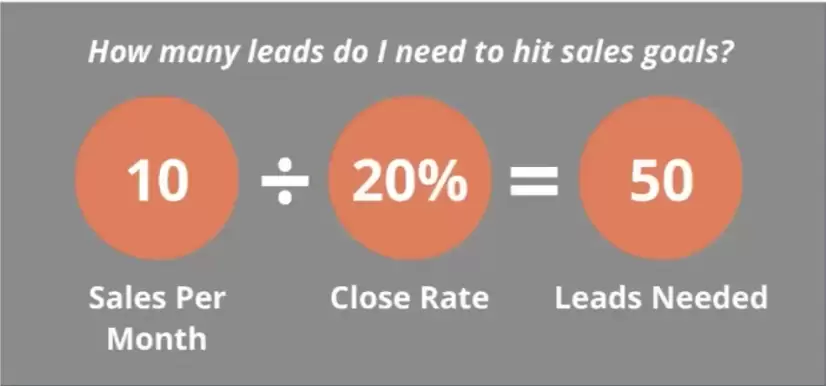
Then we can start to answer the question: how many qualified website visitors do I need per month to generate 50 leads? So we take our goal of 50 leads needed and we can start to calculate how many visitors we need to our website in a given month to hit that objective. With the 50 leads, we know that our site converts about 1 out of 20, or 5%, of visitors to a qualified lead. So we can do the math and figure out that we need about 1,000 visitors on our website each month that fit our target market or target profile.
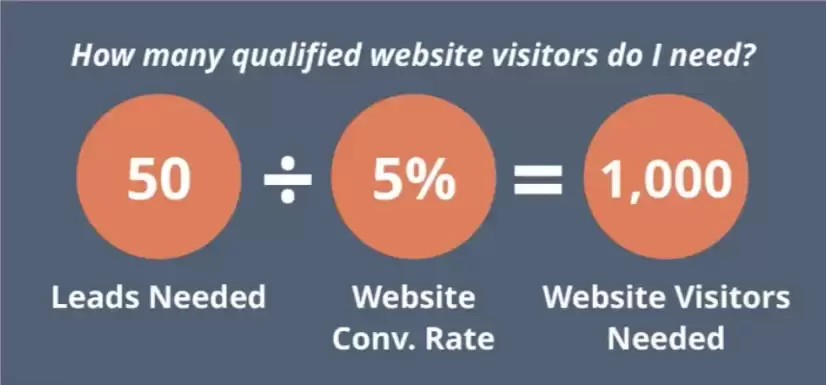
From there, depending on the strategies and tactics we're deploying, we can start to estimate how much traffic we need to go out and purchase or acquire. In a paid digital marketing channel, such as search, or display, or paid social ads, we're typically buying ads on a cost-per-click basis. For 1,000 visitors, we know that we would need to purchase about 1,000 clicks. However, if we're buying ads on a cost per thousand basis, we know we need to go out and acquire impressions or buy impressions and typically that's done based on the expected click-through rate that our ads would achieve. So, we expect a 3% click-through rate on our ads, those thousand visitors are going to require about 33,000 impressions, based on the cost-per-click model.
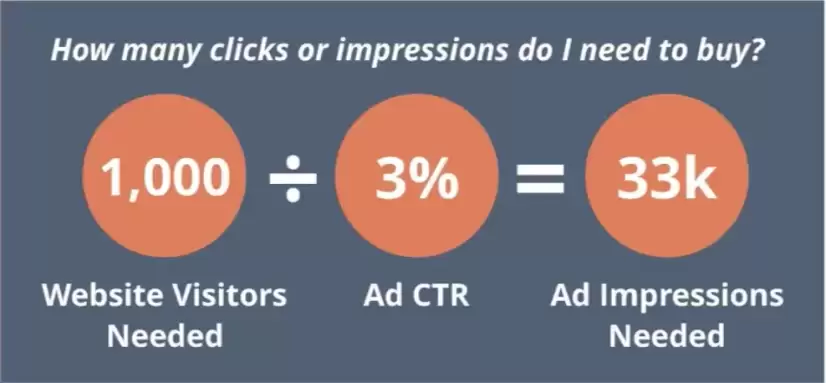
Based on the cost-per-click model in paid search or paid advertising, we can estimate in this example, about a $5 average cost per click. So to acquire the 1,000 visitors we need at $5 a piece, we need to spend about $5000 on paid media to drive enough qualified visitors to our site to generate enough leads to generate enough sales for our business. When we do the math all the way backwards, we can calculate about a $500 cost per acquisition to acquire a new customer.
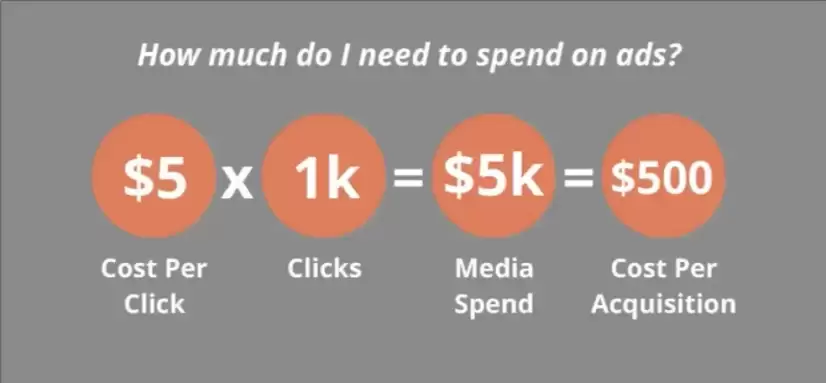
Depending on if you're selling cheap low cost widgets online that are a commodity, or if you're selling high-end, strategic consulting services, your cost per acquisition target is going to vary. But this is a math model that you can plug and play different numbers and scenarios into to see how much you can afford to spend as whole and then to acquire particular visitors. As you gather data, and your campaigns evolve, and your strategies develop, start to adjust these variables to figure out what you can do to improve your results. So taking all of that into account, I hope you can see how easy it can be to set digital marketing budgets for the coming year.
Don't let it slide like your New Year's resolutions; become a better marketer, set a budget that you can stick you and that's going to generate better results for your business.

